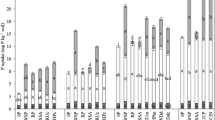Abstract
In a series of greenhouse experiments granulated phosphate fertilizers prepared by mixing triple superphosphate with phosphate rock and partially acidulated phosphate rock, ranging in their content of water souble P from 95 to 17 per cent of total P were applied to neutral and slightly alkaline (pH 6.9–7.8), sandy loam to clay soils ranging in calcium carbonate content from 2 to 35 percent. Dry matter yield of clover, alfalfa, millet or maize were obtained, P uptake determined and sodium bicarbonate extractable P in soil measured. In one field experiment triple superphosphate was compared to mixture of triple superphosphate and phosphate rock on maize. X ray difraction on one triple superphosphate — phosphate rock mixture and on one partially acidulated phosphate rock showed that both fertilizers contain mainly monocalcium phosphate and fluorapatite. After incubation in soil the dicalcium phosphate content rose and the monocalcium phosphate disappeared.
Parameters received in greenhouse experiments and in the field indicate that phosphate fertilizers composed of superphosphate and up to 50 percent phosphate rock are as efficient source of P to plants on calcareous and slightly alkaline soils as superphosphate. If this indication would be proven in extensive field experimentation it would lead to savings in acid consumption and in fertilizer manufacturing plant capacity for calcareous soils.
Similar content being viewed by others
References
Axelrod S (1978) Phosphate for direct application — phosphorite characterization and field survey of fields in the Negev, Israel. Seminar on Phosphate Rock for Direct Application, Haifa, Israel. IFDC, Muscle Shoals, Alabama p. 82–96
Dan J, Yaalon DH, Koyumdjisky H, Raz Z (1972) The soil association map of Israel. Israel J Earth Sci 21, 29–49
Engelstad OP, Jugsujind Aroon and De Datta SK (1974) Response by flooded rice to phosphate rocks varying in citrate solubility. Soil Sci Soc Am Proc 38, 524–529
Engelstad OP and Terman GL (1980) Agronomic Effectiveness of Phosphate Fertilizers. p. 311–332 in the Role of Phosphorus in Agriculture. American Society of Agronomy
Garbouchev IP (1975) Control of phosphate status in the main soils in Bulgaria. D.S. Thesis. The Lenin Allunion Academy of Agricultural Sciences. Moscow 1975
Garbouchev IP (1981) The manufacture and agronomic efficiency of a partially acidulated phosphate rock fertilizer. Soil Sci Soc Am J 45, 970–971
Gupta RP and Mishra B (1978) Phosphorus availability from rock phosphate as influenced by pyrites, wheat straw and superphosphate to maize-clover on a Mollisol. Acta Agr Acad Sci Hung 27, 126–132
Hagin J, Reinhorn Tova and Axelrod S (1978) Comparison of finely ground phosphate rocks as P sources to plants. Seminar on Phosphate Rock for Direct Application, Haifa, Israel. IFDC, Muscle Shoals Alabama p. 246–264
Hagin J and Tucker B (1982) Fertilization of dryland and irrigated soils. Adv Ser Agric Sci 12, Springer Verlag, pp. 188
Horowitz W ed. (1980) Official Methods of Analysis of the Association of Official Analytical Chemists. 13th ed. Ass Off Anal Chem, Washington
Logan J and McLean EO (1977) Diffusion of32P from partially acidulated rock phosphate. Soil Sci 123, 203–206
McLean EO (1956) Factors effecting yields and uptake of P by different crops. II: Rock phosphate and superphosphate separate and in combination under extended cropping. Soil Sci 82, 181–192
McLean EO and Balam BS (1967) Partially acidulated rock phosphate as a source of phosphates to plants. III: Uptake by corn from soils of different calcium status. Soil Sci Soc Am Proc 31, 811–814
Mokwunye AU and Chien SH (1980) Reactions of partially acidulated phosphate rock with soils from the tropics. Soil Sci Soc Am J 44, 477–482
Olsen SR, Cole CW, Watanabe FS and Dean LA (1954) Estimation of available phosphorus in soils by extraction with sodium bicarbonate. USDA Circ 939: 19 pp
Author information
Authors and Affiliations
Rights and permissions
About this article
Cite this article
Hagin, J., Katz, S. Effectiveness of partially acidulated phosphate rock as a source to plants in calcareous soils. Fertilizer Research 8, 117–127 (1985). https://doi.org/10.1007/BF01048895
Accepted:
Issue Date:
DOI: https://doi.org/10.1007/BF01048895




